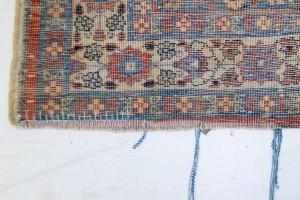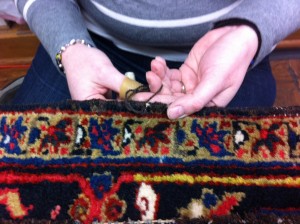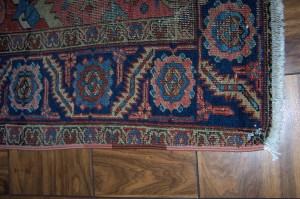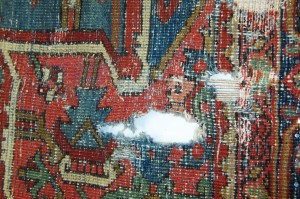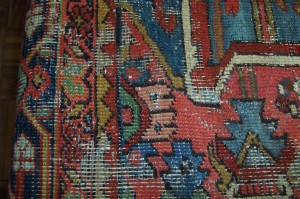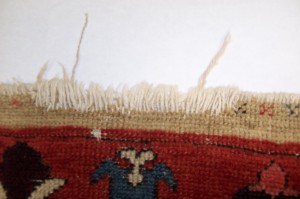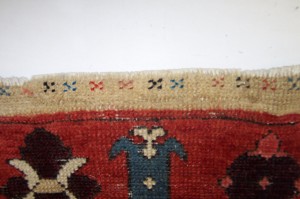At Christian Lorraine Oriental Rugs we take pride in having a hands-on and high-quality restoration/repair department. We can repair/restore fringe, selvedge, pile wear or moth damage, and holes or tears. We also work on hooked and braided rugs, rag rugs, and machine made rugs. We strive to offer several repair/restoration options to fit your needs and budget. We can also offer up-cycling options such turning a worn out rug into a pillow or cushion or cutting out worn areas to create a smaller rug. Please call or visit us for details.
Special Note: We will be implementing a nominal increase to our repair prices as of 05/01/2024.
FRINGE REPAIRS
Fringe on an Oriental rug is the actual foundation of the rug and can be secured in many ways by the original weaver. Fringe can be left long or trimmed short, can be secured by a knot or decorative stitch. Fringe wear is the most common wear to Oriental rugs. The fringe, while being decorative, is the first wear barrier, protecting the pile. Once the fringe is worn short an overcasting stitch is recommended to keep the rug foundation from raveling.
Above are two examples of overcasting. On the left you can see the wefts (horizontal) being secured as the stitch is completed. The stitching is done inside the rug so that no stitching is visible from the front side.
In addition to overcasting, we can also insert fringe. This is done by inserting a threaded needle into the rug to fill out worn areas of fringe strand-by-strand. This is mostly an aesthetic repair and additional stitching may be needed to secure the end of the rug.
We also offer sewing on a new applied fringe. Pre-made fringe is sewn onto the end of the rug to give the rug new fringe across the entire end. We do not recommend new fringe for antique rugs, as it can devalue the rug. New applied fringe is more appropriate for newer rugs, machine made rugs, and tufted rugs.
SELVEDGE (Long Sides) REPAIR
Oriental rugs are wrapped in yarn along the sides, also known as selvedge, to protect the rug from wear and raveling. As the rug is walked on the selvedge wrapping wears away and the foundation of the rug is vulnerable to wear and damage. Just as the rug can ravel on the ends, it can ravel from the sides. Rewrapping the worn selvedge yarn is an important step to keeping the rug in good condition, extending the life of the rug.
In the picture above you can see a needle is threaded with wool of a matching color, secured and wrapped to cover the damage, then secured again. If the selvedge yarn is left unwrapped the foundation can be damaged and need stitching to secure the rug. As you can see below, the rug foundation is very damaged. The damage has eroded the flower border and corner. In the second picture you can see the foundation has been secured and wrapped in yarn.
REKNOTTING REPAIRS
Often, the pile of a rug can be damaged by wear or moths. We can repair the pile by removing the damaged knots, replacing them by hand, then trimming the pile even. Reknotting is a more advanced and time consuming repair and thus more costly, but in many cases it may be worth the cost of restoration to regain the value of the rug. We can work to advise you on determining if the cost of the rug is worth the restoration cost. Below you can see that the picture on the left illustrates a large area of moth damage. Notice that the foundation of the rug is still intact and only the wool pile is damaged. The picture on the right shows the same area after restoring the pile.
REWEAVING REPAIRS
Oriental rugs can be damaged in a variety of ways causing a hole to form in the rug. Corners of a rug can be worn off or damaged. Ends and sides can be damaged from wear, improper maintenance, or chewing by our pets. These types of damages require reweaving. Reweaving repairs involve rebuilding the foundation of the rug in the area so that we can then replace the pile knots.
The picture above on the left shows the back side of the rug with several holes. The picture on the right shows the front side of the rug after reweaving the foundation and reknotting the pile.
In the above picture on the left you can see that the end of the rug was damaged. In the above picture on the right you can see that the foundation and pile have been replaced.
REHOOKING
We see many hooked rugs that have yarn pulled or holes that have formed. In the case of pulled yarn we can replace the wool loops on the existing foundation fabric. When the foundation fabric has been damaged and a hole has formed we would need to sew new foundation fabric before rehooking the wool yarn. In the picture below the client’s mother had handmade the rug and brought it to us to be restored. In the picture on the left you can see that we have sewn a new burlap foundation and have marked out a rough drawing of the pattern. The picture on the right shows the completed repair.
214 E. Franklin St.
Richmond, VA 23219
(804) 344-0081

